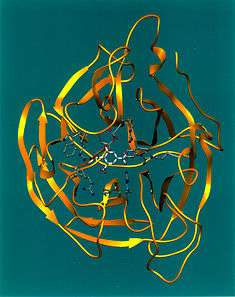Glycoside hydrolase family 34
| Neuraminidase | |||||||||
|---|---|---|---|---|---|---|---|---|---|
 Crystallographic structure of influenza A N9 neuraminidase and its complex with the inhibitor 2-deoxy 2,3-dehydro-N-acetyl neuraminic acid.[1] | |||||||||
| Identifiers | |||||||||
| Symbol | Neur | ||||||||
| Pfam | PF00064 | ||||||||
| Pfam clan | CL0434 | ||||||||
| InterPro | IPR001860 | ||||||||
| SCOP | 2bat | ||||||||
| SUPERFAMILY | 2bat | ||||||||
| CAZy | GH34 | ||||||||
| CDD | cd00260 | ||||||||
| |||||||||
In molecular biology, glycoside hydrolase family 34 is a family of glycoside hydrolases.
Glycoside hydrolases EC 3.2.1. are a widespread group of enzymes that hydrolyse the glycosidic bond between two or more carbohydrates, or between a carbohydrate and a non-carbohydrate moiety. A classification system for glycoside hydrolases, based on sequence similarity, has led to the definition of >100 different families.[2][3][4] This classification is available on the CAZy web site,[5][6] and also discussed at CAZypedia, an online encyclopedia of carbohydrate active enzymes.[7][8]
Glycoside hydrolase family 34 CAZY GH_34 comprises enzymes with only one known activity; sialidase or neuraminidase EC 3.2.1.18. Neuraminidases cleave the terminal sialic acid residues from carbohydrate chains in glycoproteins. Sialic acid is a negatively charged sugar associated with the protein and lipid portions of lipoproteins. In Influenza virus, neuraminidases prevent self-aggregation by removing the carbohydrate from the viral envelope thus facilitating the mobility of the virus to and from the site of infection. Antiviral agents that inhibit influenza viral neuraminidase activity are of major importance in the control of influenza.[9]
References
- ↑ PDB: 1nna; Bossart-Whitaker P, Carson M, Babu YS, Smith CD, Laver WG, Air GM (August 1993). "Three-dimensional structure of influenza A N9 neuraminidase and its complex with the inhibitor 2-deoxy 2,3-dehydro-N-acetyl neuraminic acid". Journal of Molecular Biology. 232 (4): 1069–83. doi:10.1006/jmbi.1993.1461. PMID 8371267.
- ↑ Henrissat B, Callebaut I, Fabrega S, Lehn P, Mornon JP, Davies G (July 1995). "Conserved catalytic machinery and the prediction of a common fold for several families of glycosyl hydrolases". Proceedings of the National Academy of Sciences of the United States of America. 92 (15): 7090–4. doi:10.1073/pnas.92.15.7090. PMC 41477. PMID 7624375.
- ↑ Davies G, Henrissat B (September 1995). "Structures and mechanisms of glycosyl hydrolases". Structure. 3 (9): 853–9. doi:10.1016/S0969-2126(01)00220-9. PMID 8535779.
- ↑ Henrissat B, Bairoch A (June 1996). "Updating the sequence-based classification of glycosyl hydrolases". The Biochemical Journal. 316 ( Pt 2) (Pt 2): 695–6. PMC 1217404. PMID 8687420.
- ↑ "Home". CAZy.org. Retrieved 2018-03-06.
- ↑ Lombard V, Golaconda Ramulu H, Drula E, Coutinho PM, Henrissat B (January 2014). "The carbohydrate-active enzymes database (CAZy) in 2013". Nucleic Acids Research. 42 (Database issue): D490–5. doi:10.1093/nar/gkt1178. PMID 24270786.
- ↑ "Glycoside Hydrolase Family 34". CAZypedia.org. Retrieved 2018-03-06.
- ↑ "Ten years of CAZypedia: a living encyclopedia of carbohydrate-active enzymes". Glycobiology. 28 (1): 3–8. December 2018. doi:10.1093/glycob/cwx089. PMID 29040563.
- ↑ Couch RB (1999). "Measures for control of influenza". PharmacoEconomics. 16 Suppl 1: 41–5. doi:10.2165/00019053-199916001-00006. PMID 10623375.